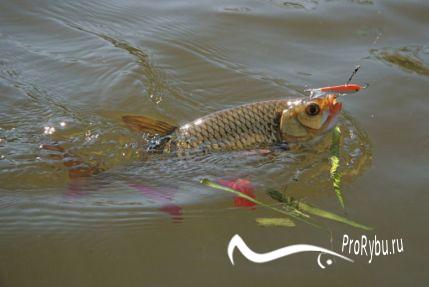Common name: Smallmouth bass, a.k.a. black bass, smallie, redeye, bronzeback, brown bass, brownie.

Scientific name: Micropterus dolomieu (Micropterus means “small fin”; dolomieu was named after M. Dolomieu, a French mineralogist.
Appearance: A true bass, smallmouths are marked with dark, verticalstripes on greenish scales, with more dark bars around the eyes, radiating backwards. Their cheeks are lined with a diagonal row of deep, blunt scales. Smallmouth range from 14 inches to 17 inches,sometimes reaching lengths of18 inches or more. The spiny dorsal fin has ten thin rays. Its mouth is soft and tender, without any sharp teeth.
Distribution: Good-tasting and hard-fighting, smallmouth bass is a popular North American gamefish originally native to the Great Lakes and a few Midwestern rivers. Today, smallmouth bass thrive in clear, cool, rocky lakes and streams four continents (North America, Europe, Africa, and Asia).
Spawning: The spawning season for smallmouth varies considerably from one body of water to the next depending on the environment and weather, complicating efforts to regulate smallmouth fishing on a state-wide basis. However, most smallmouth populations finish spawning by mid-summer.
Male smallmouths will build several nests in measuring up to three feet in diameter in gravel-bottomed water between 4’ and 20’. Once he has constructed a nest that he finds satisfactory, the male will lead up to half a dozen females to it. The females deposit their eggs in the same nest, though a high percentage of these eggs are infertile (the average nest contains roughly 2000 fertile eggs). As the male fertilizes the eggs, the female will lie flat on the bottom of the lake, exhausted (many older smallmouths never recover from the strain of egg-laying), excreting a creamy substance that envelops her entire body. The male, meanwhile will defend the nest against all intruders – both smallmouths and other species.
After the spawn, smallmouths divide into two groups – one which goes out in search of forage fish in depths between 15’ and 30’, and a second that remains near the spawning grounds.
Angling: The scrappiest fighter, relative to its size, in fresh water, smallmouth bass can sometimes be found swimming alone, or else in schools of anywhere up to a thousand fish (in the Great Lakes). Smallies will change their habits frequently throughout the season – sometimes feeding aggressively in open water, other times clinging cautiously to rock formations (where they exhibit a chameleon-like ability to change color to match their surroundings). They prefer cool, deep, rock-bottomed waters, where they can feed on crustaceans, insects, minnows, and small baitfish.
Smallmouth will aggressively pursue anything smaller than they are, yet startle easily at the first sign of larger predators. The best tactic pre-spawn is to cast quietly in the shallows, where smallies like to feed on spawning crustaceans, near rocks, logs, submerged islands, and ridges, with your rod tip up and the line taut. Otherwise, troll with your motor off on about sixty feet of line. Casting long-distance with ultra-light equipment using crankbaits, spinners, or small spoons is one way to get results, or try a fly-fishing with deer-hair bugs.
During and after the spawn, smallmouth fishing grows more difficult as the fish move frequently between feeding areas, cruising different depths in search of different prey, throughout the day. Fall and winter are generally slow times for smallmouth fishing, as the fish retreat to the deepest, darkest depths and feed relatively sparingly. Live bait – nightcrawlers or crawfish – is the most reliable way to get a smallmouth’s attention later in the year, though some states ban the most effective types. Larger artificial baits are also effective during this season. Cast or troll deep-diving baits, wait for a strike, then try again. The rule of the thumb is that, the colder and deeper the water, the less you should move the lure and the longer you should wait for a strike (and vice versa in warmer, shallower water). Experiment with different sizes and presentations at different depths.
When a smallmouth strikes, you’ll know it. Don’t be caught off guard, as they will start fighting immediately. Smallmouth will twist, turn, and struggle vigorously for a long time, and often succeed in shaking (or ripping) free of the hook. If cover is available, smallmouth will instinctively head for it, tangling the line in weeds or snagging it on a rock. Whatever the case, a smallmouth will put any angler’s rod technique to the test.
Once caught, smallmouth make for good eating, and decent trophies. However, most fishermen opt to catch-and-release until late summer, so as not to interfere with the spawn. The potential for disrupting the spawn is high, and it only takes a few reckless fishermen to ruin the rest of the year for everyone.


